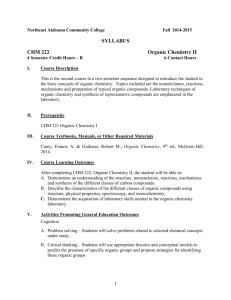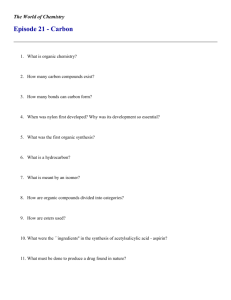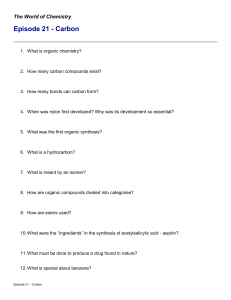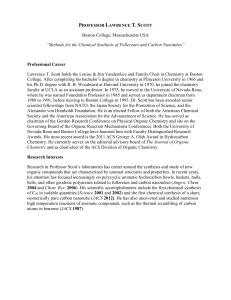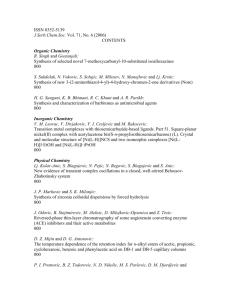CHM 221 - Northeast Alabama Community College
advertisement
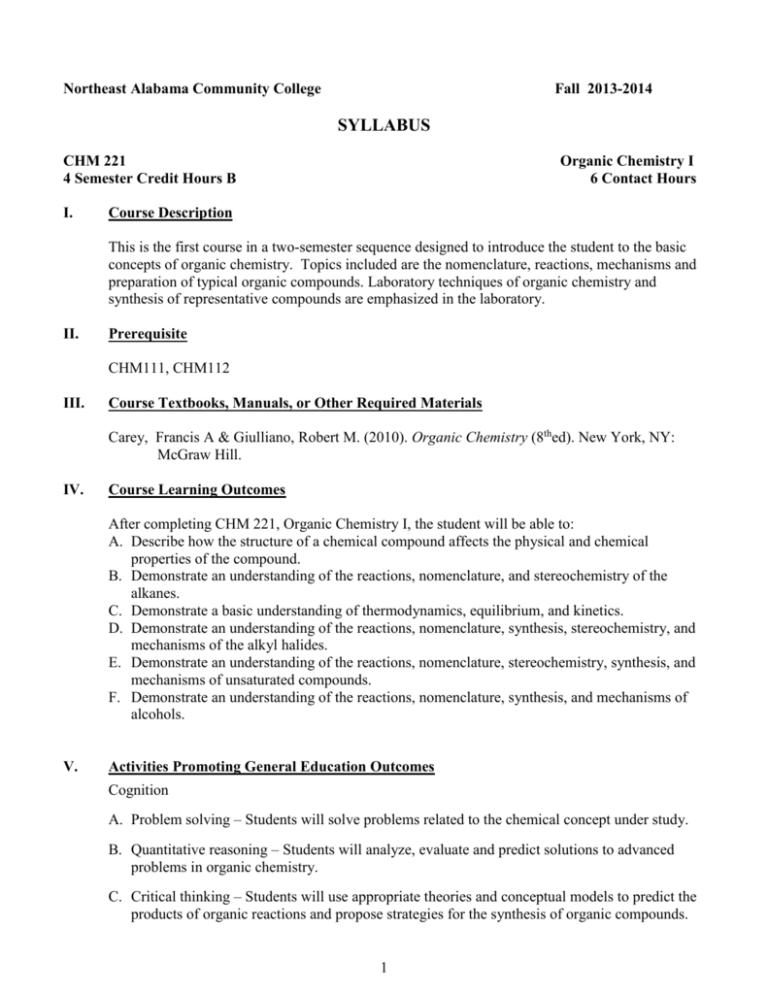
Northeast Alabama Community College Fall 2013-2014 SYLLABUS CHM 221 4 Semester Credit Hours B I. Organic Chemistry I 6 Contact Hours Course Description This is the first course in a two-semester sequence designed to introduce the student to the basic concepts of organic chemistry. Topics included are the nomenclature, reactions, mechanisms and preparation of typical organic compounds. Laboratory techniques of organic chemistry and synthesis of representative compounds are emphasized in the laboratory. II. Prerequisite CHM111, CHM112 III. Course Textbooks, Manuals, or Other Required Materials Carey, Francis A & Giulliano, Robert M. (2010). Organic Chemistry (8thed). New York, NY: McGraw Hill. IV. Course Learning Outcomes After completing CHM 221, Organic Chemistry I, the student will be able to: A. Describe how the structure of a chemical compound affects the physical and chemical properties of the compound. B. Demonstrate an understanding of the reactions, nomenclature, and stereochemistry of the alkanes. C. Demonstrate a basic understanding of thermodynamics, equilibrium, and kinetics. D. Demonstrate an understanding of the reactions, nomenclature, synthesis, stereochemistry, and mechanisms of the alkyl halides. E. Demonstrate an understanding of the reactions, nomenclature, stereochemistry, synthesis, and mechanisms of unsaturated compounds. F. Demonstrate an understanding of the reactions, nomenclature, synthesis, and mechanisms of alcohols. V. Activities Promoting General Education Outcomes Cognition A. Problem solving – Students will solve problems related to the chemical concept under study. B. Quantitative reasoning – Students will analyze, evaluate and predict solutions to advanced problems in organic chemistry. C. Critical thinking – Students will use appropriate theories and conceptual models to predict the products of organic reactions and propose strategies for the synthesis of organic compounds. 1 VI. Outline of Course Topics A. Lecture Topics 1. Review of selected general chemistry topics 2. Introduction to functional groups 3. Alkanes—nomenclature, physical properties, conformations, reactions 4. Cycloalkanes—cis-trans isomerism, ring strain, conformations of cyclohexane, bicyclic compounds 5. Study of organic reactions—equilibrium, kinetics, free energy, thermodynamics, mechanisms 6. Stereochemistry—chirality, stereoisomers, enantiomers, (R) and (S) nomenclature, optical activity, Fischer projections, diastereomers, meso compounds, resolution of enantiomers 7. Alkyl halides—nomenclature, structure, physical properties, synthesis, substitution reactions, elimination reactions, reaction stereochemistry, reaction mechanisms 8. Alkenes—unsaturation, nomenclature, structure, physical properties, Saytzeff rule, synthesis, Markovnikov’s rule, reaction stereochemistry, reaction mechanisms, regioselective reactions 9. Alkynes—structure, nomenclature, physical properties, synthesis, reactions 10. Alcohols—structure, nomenclature, physical properties, synthesis, Grignard reagents, reactions B. Laboratory Topics 1. Check in, laboratory safety guidelines 2. Melting Points 3. Crystallization 4. Simple distillation 5. Fractional distillation 6. Steam distillation 7. Extraction—isolation of caffeine 8. Thin-layer chromatography 9. Synthesis of t-butyl chloride 10. SN2 synthesis of 1- bromobutane 11. Reactions of alcohols 12. Biosynthesis of ethanol 13. Synthesis of cyclohexene 14. Synthesis and reactions of acetylene 15. Lab Final, Check Out VII. Methods of Instruction A. B. C. D. Lecture/Discussion Chemistry laboratory Blackboard (Homework/Tutorials) Power Point Presentations 2 VIII. Evaluation and Assessment A. Procedures for Assessment of Student Achievement 1. Written examinations 2. Laboratory Reports 3. Formal Lab Reports 4. Homework 5. Comprehensive final Grades will be given based upon A = 90 – 100%, B = 80 – 89%, C = 70 – 79%, D = 60 – 69%, and F = below 60%. B. Departmental Assessment of General Education Outcomes 1. Cognition--Problem solving skills will be measured by an exercise on the calculation of empirical and molecular formulas for typical organic compounds. Students will demonstrate attainment of the general education outcome of Cognition-Problem solving skills by scoring at least 70% or higher on the selected exercise. 2. Quantitative reasoning will be assessed by selected test questions on conformational analysis of butane and cyclohexane. Students will demonstrate attainment of the general education outcome of Cognition--Quantitative reasoning skills by attaining a score of at least 70% or higher on the selected test questions. 3. Critical thinking will be assessed by a quiz on competition between SN1, SN2, E1, and E2 reaction mechanisms of the alkyl halides. Students will demonstrate attainment of the general education outcome of Cognition-Critical thinking skills by scoring at least 70% or higher on the selected quiz. 4. Assessment of all sections of Chemistry 221 will occur at least once every five years. The assessment will consist of selected laboratory exercises and tests as indicated above. Each instructor will complete the appropriate form documenting student learning outcomes and submit it to the division director. C. Use of Assessment Findings During the Fall In-service of the year following the scheduled review of CHM 221, a committee will review all course assessment materials submitted by the instructors and division director. The committee will submit a report of any recommended curriculum changes for CHM 221 to the division director, who will then submit them to the Student Learning Outcomes (SLO) Committee. Upon approval by the SLO Committee, a copy will be filed with the Office of Institutional Planning and Assessment. IX. Attendance Students are expected to attend all classes for which they are registered. Students who are unable to attend class regularly, regardless of the reason or circumstance, should withdraw from that class before poor attendance interferes with the student’s ability to achieve the objectives required in the course. Withdrawal from class can affect eligibility for federal financial aid. 3 X. Statement on Discrimination/Harassment NACC and the Alabama State Board of Education are committed to providing both employment and educational environments free of harassment or discrimination related to an individual’s race, color, gender, religion, national origin, age, or disability. Such harassment is a violation of State Board of Education policy. Any practice or behavior that constitutes harassment or discrimination will not be tolerated. XI. Statement of Adherence to ADA Guidelines The Rehabilitation Act of 1973 (Section 504) and the Americans with Disabilities Act of 1990 state that qualified students with disabilities who meet the essential functions and academic requirements are entitled to reasonable accommodations. It is the student’s responsibility to provide appropriate disability documentation to the College. 4
